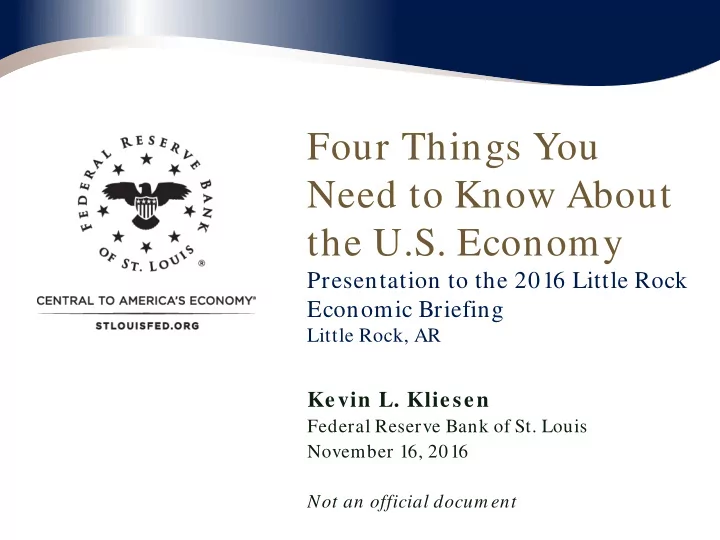

Four Things You Need to Know About the U.S. Economy Presentation to the 2016 Little Rock Economic Briefing Little Rock, AR Kevin L. Kliesen Federal Reserve Bank of St. Louis November 16, 2016 Not an official docum ent
Disclaimer The views I will express today are my own and do not necessarily reflect the positions of the Federal Reserve Bank of St. Louis or the Federal Reserve System.
The Big Picture • The economy is likely to see above-trend growth over the second half of the year. • New President, new policies—but until they are enacted, it’s difficult to know their economic effects. • The labor market is healthy, interest rates have popped, and inflation expectations are rising. • Market-based expectations for a rate hike in December are very high, but monetary policy will likely remain very easy for the foreseeable future.
#1: We’re at Full Employment • In the aftermath of the Great Recession, the U.S. unemployment rate peaked at 10% in October 2009. • The recession was particularly difficult for some workers (e.g., the less-educated and those employed in the housing and manufacturing industries). • But we’re into the eighth year of the expansion, and the unemployment rate is below 5%. • Job gains this year have averaged 181,000/month.
Estimates of the economy’s trend job growth are well under 100,000.
#2: U.S. GDP Growth has the Slows • During this expansion, real GDP growth rate has averaged about 2%—the weakest since the 1930s. • Prior to the Great Recession and Financial crisis, real GDP growth averaged 3% per year. • Many aspects of our future society depend crucially on how high the sustainable growth rate of real GDP turns out to be. • The key question is why has growth slowed and what will it take to turn it around?
Do professional forecasters have rose- colored glasses or is the Fed too bearish? Projected Long-Term Real GDP Growth According to Professional Forecasters and FOMC (Fed) Policymakers Percent changes 3.0 2.5 2.3 2.0 1.8 FOMC Professional Forecasters 1.5 1.0 2009 2010 2011 2012 2013 2014 2015 2016 SOURCE : Survey of Professional Forecasters and Federal Reserve Summary of Economic Projections.
#3: Labor Productivity Growth Stinks • Labor productivity is the value of output produced (real goods and services) divided by hours worked. • Few metrics in macroeconomics are more important than the growth rate of productivity. • Productivity depends on many things: skill levels, technology, investment rates, government policies. • IMPORTANT! Faster productivity growth = faster real GDP growth = faster growth of real wages = rising living standards.
What Drives Economic Growth? • Economists have identified four key factors: – Investment in plant and equipment as a share of GDP – Educational attainment per person – R&D: The search for new ideas – Number of people in the economy • One big solution to the problem of low productivity growth: The discovery of new ideas.
Possible explanations for the slowdown in labor productivity growth . 1. We’ve run out of new “big ideas”—i.e., all the low- hanging fruit has been picked. 2. It’s a head-fake: bad data or we can’t measure new innovations accurately. 3. Government policies are hindering not helping. 4. It’s being delayed—just wait!
#4: Low Inflation is the New Normal • The Fed’s preferred inflation measure has been below the 2% target rate since mid-2012. • A key tenet of central bank practice is that an inflation target anchors inflation expectations. • If the target is viewed as credible by the public, then inflation should deviate very little from the target. • There may be periods, though, when sharp changes in some prices cause inflation to deviated from the target.
Falling oil prices lowered headline inflation but not many other prices. The Fed's Preferred Inflation Measure and an Alternative Measure 12-month percent changes 3.5 Headline PCE Alternative 2% Target 3.0 2.5 2.0 1.7 1.5 1.2 1.0 0.5 0.0 Jan.2010 Apr.2011 Jul.2012 Oct.2013 Jan.2015 Apr.2016 SOURCE : BEA and FRB Dallas. NOTE : Data through Sept. 2016.
The bond market’s inflation fear gauge is ignoring the drop in oil prices! Inflation Expectations (5- to 10-Years Ahead) and Oil Prices $60 2.25 Brexit, June 24 $55 2.00 $50 $45 1.75 $40 Inflation 1.50 $35 Expectations (Right) $30 Spot WTI (Left) 1.25 $25 $20 1.00 7/29/2015 10/29/2015 1/29/2016 4/29/2016 7/29/2016 10/29/2016 NOTE : Last actual observation is Nov. 14, 2016
Fearless Forecast for the next 3 Years. • Projected averages, 2016 to 2019: – Real GDP growth: Around 2% – Unemployment rate: About 4.75% – Headline inflation: 2% • Punchline: More of the same—unless something unexpected happens!
Recommend
More recommend